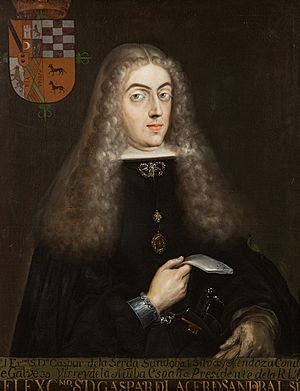Gaspar de la Cerda, 8th Count of Galve facts for kids
Quick facts for kids
The Most Excellent
The Count of Galve
|
|
|---|---|
 |
|
| 30th Viceroy of New Spain | |
| In office November 20, 1688 – February 26, 1696 |
|
| Monarch | Charles II |
| Preceded by | Melchor Portocarrero |
| Succeeded by | Juan Ortega |
| Personal details | |
| Born | 11 January 1653 Pastrana, Spain |
| Died | March 12, 1697 (aged 43) El Puerto de Santa María, Spain |
Gaspar de la Cerda Silva Sandoval y Mendoza, 8th Count of Galve (born January 11, 1653 – died March 12, 1697) was an important leader in New Spain. He served as the viceroy, which was like a governor, from November 20, 1688, to February 26, 1696. New Spain was a large area that included much of modern-day Mexico and parts of the United States.
Contents
Viceroy of New Spain
Gaspar de la Cerda Sandoval Silva was only 35 years old when he became viceroy in May 1688. He arrived in Veracruz in October and traveled to Mexico City. He officially started his job on November 20, 1688.
Dealing with French Explorers
Soon after he arrived, the viceroy learned about French explorers in what is now Texas. These Frenchmen were trying to set up a colony. Viceroy Cerda Sandoval sent soldiers to investigate. The Spanish found a French fort and captured two French adventurers. They also rescued two Spanish prisoners. This showed the Spanish that the French wanted to settle in this area.
Protecting the Coasts
In 1689, the viceroy worked to protect New Spain's coasts. He gathered money to send ships from Acapulco to find pirates in the Pacific Ocean. He also fought against English people who were illegally cutting down valuable wood in Tabasco and Campeche. These English workers were sending the wood to Jamaica and Europe.
Helping the People
In 1689, there were very heavy rains. Viceroy Cerda Sandoval made sure that the drainage systems were working well to prevent floods. In 1691, he started schools to teach Spanish to the native people. These schools were very successful. Larger towns had separate schools for boys and girls, while smaller places had one school for everyone.
Indian Revolts
During his time as viceroy, there were some uprisings by native groups. The Tarahumara people in Nueva Vizcaya (a region in northern Mexico) revolted. There were also problems with some native groups in Texas. These groups had generally been peaceful and wanted to join the Spanish and become Christians. However, Spanish soldiers and settlers treated them badly. This caused the native people to revolt and force the soldiers and missionaries to leave. Luckily, the governor of Coahuila y Texas was able to calm things down without fighting.
Mexico City Riot of 1692
In 1692, a serious drought caused a big shortage of food, especially corn. Many people in Mexico City were very hungry. On June 8, 1692, a large crowd gathered outside the viceroy's palace. They set the palace on fire and threw stones.
Don Carlos de Sigüenza y Góngora, a famous scholar, bravely saved many important documents from the burning palace. Some nearby homes and shops also burned. Sigüenza later wrote a detailed story about this riot.
After the riot, many people were arrested. Most of them were native people or of mixed heritage, but some Spaniards were also involved. The authorities quickly tried to find out who started the riot. Many people were punished, but some were found innocent because there wasn't enough proof.
Before leaving Mexico City, the viceroy asked an artist named Cristóbal de Villalpando to paint a picture of the main square. This painting, finished in 1695, shows the busy city life. It also clearly shows the damage to the viceroy's palace from the fire. This painting was a reminder of the major riot that happened during his time as viceroy.
In 1693, Don Carlos de Sigüenza y Góngora started El Mercurio Volante. This was the very first newspaper in New Spain.
In 1695, with help from the English, the viceroy attacked French settlers on the island of Española (modern-day Haiti and Dominican Republic). The French base was destroyed, and many cannons were captured. In the same year, Cerda Sandoval also founded a fort called the Presidio at Panzacola, Florida.
Also in 1695, a famous Mexican poet named Sor Juana Inés de la Cruz died in Mexico City during an epidemic.
Later Life
In September 1695, Cerda Sandoval asked to return to Spain. He tried to give his job to the bishop of Puebla, Manuel Fernández de Santa Cruz, but the bishop refused. Soon after, Juan Ortega y Montañés, the bishop of Michoacán, accepted the role of viceroy.
Cerda Sandoval then went back to Spain. He passed away on March 12, 1697, in El Puerto de Santa María.
See also
 In Spanish: Gaspar de la Cerda y Mendoza para niños
In Spanish: Gaspar de la Cerda y Mendoza para niños

